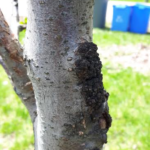Hi! I am sending you a picture of my plum tree. Do you know what the black growth is? What should I do with it? Thank you, Kate
Thank you for including the photo in your inquiry about your plum tree. The black growth is most likely a bacterial canker infection which commonly affects fruit trees such as cherries and plums. Is this the first year that this problem has been evident? Outbreaks of this disease are often associated with the cool, wet weather that southern Ontario has experienced this spring. Was there a branch that was previously pruned at the site of the infection? Was the branch diseased or dying? If so, the canker could be a Cytospora fungal infection.
Regardless of the cause, the infections usually start in the late fall or early spring when the tree is dormant. During the late spring as the temperature rises, the growth of the fungal or bacterial spores decreases; the tree will form a callus layer around the canker. As the tree begins active growth in the spring, the canker area may ooze a gummy sap that will gradually turn dark. That is probably what you are seeing on the trunk of your plum tree.
The recommended way to deal with the affected area, assuming that it is relatively small, is to cut out the infection “using the following method. Cut away bark above and around the edges of the infected area. Use sharp tools, and leave wound margins smooth and neat.” Make sure that the knife or chisel blade are disinfected “by swabbing it in a solution of 7 parts denatured alcohol and 3 parts water”. Dispose of all infected material.
If the plum tree becomes more severely affected with the canker, you may have to consider removing the tree as it will eventually die. We hope that you (or a certified arborist) will be able to help your plum tree survive.
For more information about managing canker infections, please see: https://extension.psu.edu/plants/gardening/fphg/stone/diseases/cytospora-canker-of-stone-fruits


